Spotted Lanternfly
ENTFACT-465: Spotted Lanternfly: Be on The Lookout for This Invasive Species | Download PDF
By Jonathan L. Larson, Ric Bessin, Extension Entomologists and Ellen Crocker, Extension Forestry
University of Kentucky College of Agriculture
Fast Facts
- Spotted lanternfly (SLF) is an invasive species, originally from Asia, that was first confirmed in the US in 2014.
- The adult is distinctive looking, with front wings that have a mixture of stripes and spots while the back wings have a bright red color that contrasts with white, black, and khaki coloration on the rest of the body.
- Tree of heaven is their primary host plant, but they are known to feed on over 70 different species of plants including grapes, apples, and maples.
- If you believe you have seen or captured a spotted lanternfly, please take a photo or capture the specimen and get it identified by the entomology department or submit it to a local extension professional.

Figure 1: Adult spotted lanternflies are distinctive looking insects with a pink-khaki coloration and spots and stripes on their wings. (Photo: Lawrence Barringer, Pennsylvania Department of Agriculture, Bugwood.org)
Potential Hosts
There are over 70 potential hosts for SLF. Feeding preferences change as they age, with immature nymphs feeding on a broader range of plants while adults will preferentially feed on tree of heaven. Potential hosts include willow, maple, apple, walnut, pine, poplar, and stone fruit trees. They may also be found on hops plants and grape vines.
Symptoms, Life Cycle, and Descriptions of Life Stages
Spotted lanternflies feed by inserting piercing-sucking mouthparts into the host plant which allow them to suck sap from the plant. This drain of resources stresses plants and results in other notable signs of infestation including:
- Wilted foliage
- Branch dieback
- Accumulation of “honeydew”, a sticky, sugary fecal material
- Black sooty mold growing in honeydew
- Increased visitations of flies, bees, and wasps who are feeding on honeydew
SLF infestations may also cause sap to ooze from infested trees and sites often have a fermented odor to them.
In its known US distribution, the spotted lanternfly has only one generation per year. As true bugs, these insects develop through incomplete metamorphosis- starting life as an egg, then progressing through nymphal stages, before becoming an adult.
Eggs
SLF overwinters as an egg and egg masses can be found between September of one year into June of the following year. Individual eggs are laid in masses that typically contain 30-40 eggs but can hold as many as 75-78. The mass is coated in a putty like substance produced by the mother. Initially this coating is white but darkens to a tan or khaki coloration. The result is egg masses that look like a smear of mud (Figure 3). They can be found on natural objects like logs but have also been found on many human-made objects like fence posts, lawn furniture, mailboxes, and automobiles, amongst others. SLF is a “hitchhiking” pest. When eggs are laid on firewood or cars, humans often inadvertently help to introduce this pest into new areas. Once nymphs have emerged from the eggs, the spent eggs are uncovered and empty, resembling open coin purses (Figure 4).
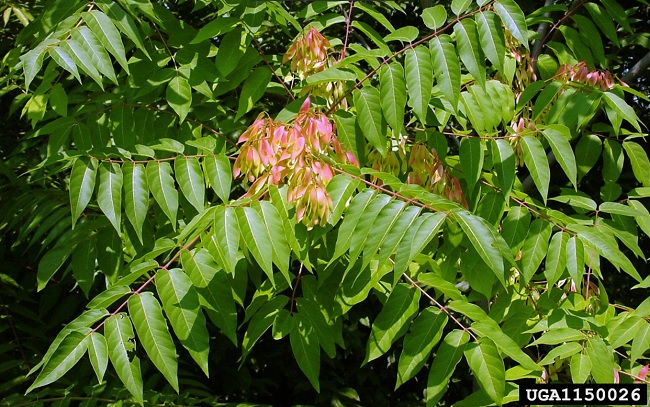
Figure 2: Tree of Heaven has several distinguishing characteristics, including their long leaflets, strong odor, and cantaloupe like bark. (Photo: Chuck Bargeron, University of Georgia, Bugwood.org)
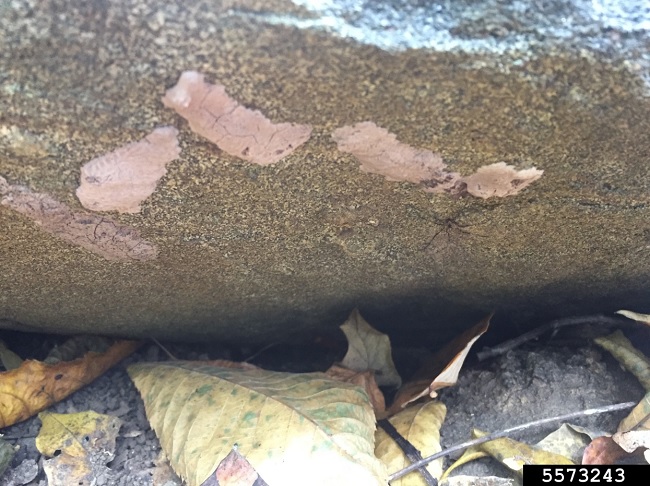
Figure 3: Spotted lanternfly egg masses look like patches of dry, brown, mud and can be found on trees, stones, and other objects outside. (Photo: Emelie Swackhamer, Penn State University, Bugwood.org)
Tree of Heaven
Tree of heaven (Figure 2) (Ailanthus altissima) is an invasive plant and the preferred host of SLF. It is also a major problem on its own. A fast-growing tree that tolerates a wide range of conditions, thriving in both urban and woodland settings and outcompeting native species. Usually, it is found in disturbed urban areas, and along roadsides and railroad tracks, it also invades natural areas, particularly in woodlands following harvests when papery wind-born seeds can rapidly colonize and grow in dense stands.
Tree of Heaven ID:
- Large (1-4 feet long) compound leaves with many (10-24) spear shaped leaflets with smooth edges
- Small lobes at the base of leaflets each have a distinctive glandular bump on the underside
- Branches and stems have an unpleasant smell when cut (similar to rancid peanut butter)
- Smooth green bark when young, turning gray with age
- Can be large trees (>80 feet tall) but more often seen as dense thickets of smaller trees that are clonally connected through roots
- Distinguish from native look-alikes like black walnut and sumac
- Black walnut leaflets will have more than 10 veins
- Sumac leaflets have saw tooth like edges
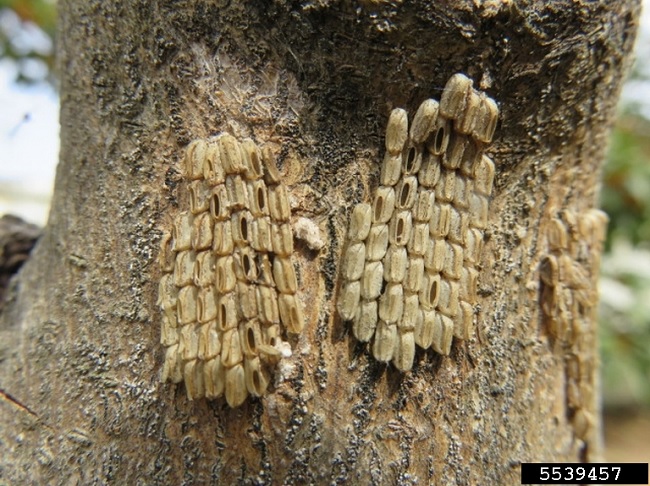
Figure 4: After hatching, spotted lanternfly eggs are no longer covered with the brown substance. The spent eggs are also open, resembling an open coin purse. (Photo: Kenneth R. Law, USDA APHIS PPQ, Bugwood.org)
Nymphs
Spotted lanternfly develops through four nymphal stages before reaching adulthood. During the first three instars, they are black with white dots (Figure 5). In the final nymphal instar, they are black with red patches and white dots. The nymphs with red patches are about half an inch in length (Figure 6). All nymphal stages will jump when approached. Immature spotted lanternflies can be seen from April through October.
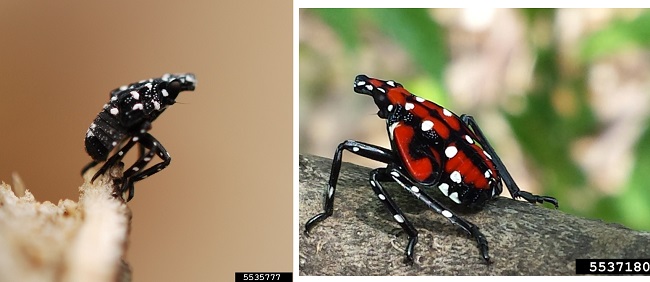
Figure 5 (L): Younger nymphs are black with white dots.
Figure 6 (R): Older nymphs are black with red patches and white dots.
(Photos: Lawrence Barringer, Pennsylvania Department of Agriculture, Bugwood.org)
Adults
Adult SLF are over an inch long. They are part of a group known as the planthoppers, which are related to other insects like treehoppers, leafhoppers, and cicadas. Adult SLF are quick and will run and jump when approached. When viewed from the side, lanternflies look vaguely tear drop shaped as their head comes to a point (Figure 7). They have long legs, and their wings are held tent-like over the abdomen. Half of the first pair of wings have black dots, while the other half is covered with broken black lines (Figure 8). The color of the wings is generally described as khaki pink. When the front wings are open, the second, smaller pair of wings underneath can be seen. These are partially red with black spots, which contrasts with black and white on the other portions of the wings. Adults are typically seen from July through November.
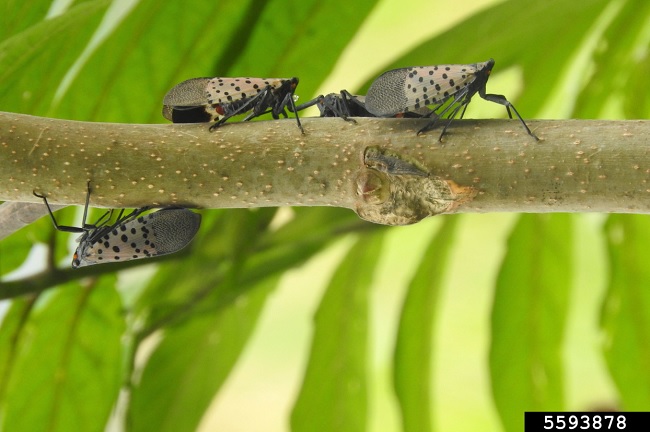
Figure 7: Spotted lanternfly is a planthopper and they share a similar shape with cicadas, treehoppers, and leafhoppers. When viewed from the side, the lanternfly is vaguely teardrop shaped. (Photo: Richard Gardner, Bugwood.org)

Figure 8: Spotted lanternflies are unique looking insects, with distinctly colored wings and unique patterns. The front wings are khaki pink with black spots and broken black lines. The back wings are a mixture of red, white, and black. (Photo: Lawrence Barringer, Pennsylvania Department of Agriculture, Bugwood.org)
Potential Impacts for Kentucky
This pest threatens to impact wine production, apple growing, Christmas tree production, hops growers, and the sizable forest industries of Kentucky. As these insects feed, they decrease the plant’s health and can cause mortality. Their high numbers on host plants and the recruitment of black sooty mold and stinging insects by honeydew production can decrease the recreational value of parks and backyards that are infested. Although the outcomes of infestations in diverse woodlands settings and natural areas are less clear than in more uniform agricultural and landscape settings, the added drain on trees’ resources that SLF will cause may compound existing tree stress issues and trigger decline in a range of settings.
The regulatory response to an invasive species as problematic as SLF can also impact Kentuckians. Restrictions on the movements of goods like lumber, the need for quarantines, and even the requirement of permits to travel or move goods out of infested areas could all have financial or quality of life consequences for Kentuckians in infested areas.
What Can You Do?
If you think you have seen a SLF, you need to either capture the specimen or take a picture of it. There needs to be some sort of evidence to verify what you have seen. There are other insects in the state that resemble this pest, some of which are highlighted in Figure 9.
If SLF is discovered, and the infestation is relatively contained, efforts will be made to locally eradicate the insects to prevent their continued local spread and establishment. This is done with a combination of insecticide treatment of potential host trees and eradication of tree of heaven and other preferred hosts. The sooner SLF is reported the better and the higher the probability of effectively controlling it.
If you do have evidence that needs evaluated, please submit photos or specimens directly to the Department of Entomology at UK through an email to the authors of this publication or through Facebook, at Kentucky Bugs. You may also reach out to your local county extension office for guidance on how to send the sample in.
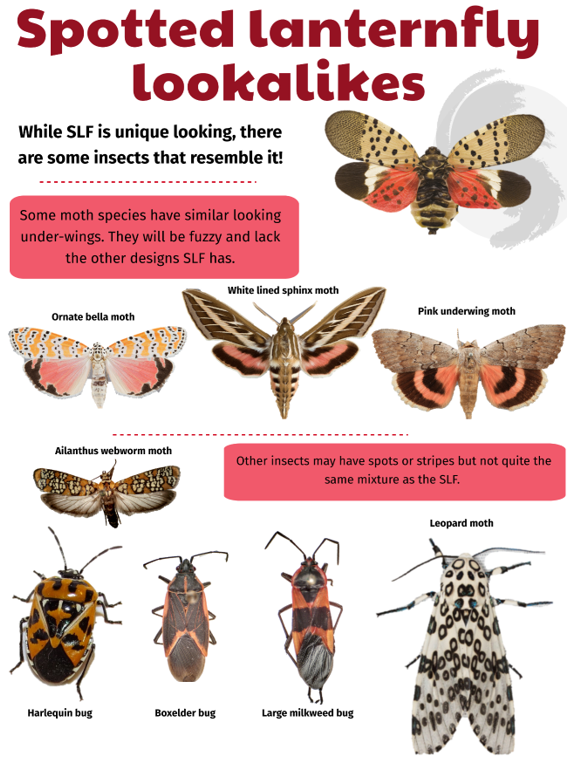
Figure 9: There are numerous insects that can be misidentified as SLF upon first glance. Some of these are moths that share similar coloration, others are true bugs with similar markings.
Issued: 3/22
CAUTION! Pesticide recommendations in this publication are registered for use in Kentucky, USA ONLY! The use of some products may not be legal in your state or country. Please check with your local county agent or regulatory official before using any pesticide mentioned in this publication.
Of course, ALWAYS READ AND FOLLOW LABEL DIRECTIONS FOR SAFE USE OF ANY PESTICIDE!
Images: University of Kentucky Entomology unless otherwise specified.
